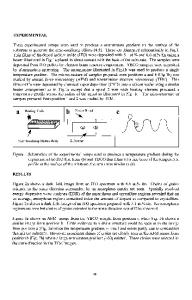Fullerenes Control Grain Size and Orientation in Nanomagnetic Thin Films
- PDF / 155,230 Bytes
- 1 Pages / 612 x 792 pts (letter) Page_size
- 79 Downloads / 375 Views
demonstrate the potential of H-TPIP to control the resulting morphology (both domain size and domain distribution) in phase-separated diffractive structures. Because of the nonlinear and local nature of the process, the formation of phase separated-diffractive structures internal to a surrounding medium is also potentially possible. Thus, one might envision writing complex optical structures (such as lenses) in the interior of a surrounding solid material using this holographic technique. GREG KHITROV
Fullerenes Control Grain Size and Orientation in Nanomagnetic Thin Films Most investigations into fullerene (C60) applications have involved doping either the interior or exterior of the fullerene cage with other atoms to achieve unique properties. Now researchers at Rice University and the National Institute of Standards and Technology (NIST) have succeeded in synthesizing nanomagnetic thin films of Co, Fe, and CoFe by co-deposition with C60 to control the grain size, grain orientation, and magnetic properties of the resulting films. Magnetization curves show high out-of-plane remanence, high coercivity, and fast magnetic switching properties. As reported in the November 13 issue of Applied Physics Letters, samples were prepared by simultaneously subliming high purity C60 powder at 500–650°C and evaporating Co and Fe from pure metal rods in an ultrahigh vacuum. Thin films of Co, Fe, Co-C60, Fe-C60, and CoFe-C60 of 100 nm thickness were deposited on amorphoussilicon-nitride-coated Si substrates, then analyzed using wavelength dispersive spectrometry (WDS), mass spectrometry, Raman spectrometry, transmission electron microscopy (TEM), and vibrating sample magnetometer (VSM). Using WDS, the atomic compositions of two promising films were shown to be Co162C60 and Fe73C60. Mass spectrometry revealed high concentrations of C60 in these samples, with very little decomposition product, demonstrating the stability of C60 in the metallic matrix. TEM images of the Co162C60 sample showed highly columnar Co grains of 11 nm diameter, much finer than the 22 nm grains obtained in the pure Co film. A carbon-containing phase identified as C60 filled the grain boundaries. Similarly, the Fe73C60 film had a finer diameter (5 nm) than the pure Fe film (15 nm). The grains in the Fe73C60 film were approximately 50 nm long, and were oriented perpendicularly to the substrate. In contrast, the grains in the pure Fe film were randomly oriented.
MRS BULLETIN/DECEMBER 2000
The investigators attribute the controlled microstructure to a self-assembly grain growth model involving migration of C60 to the edges of metallic nuclei, formation of an interconnected C60 structure that confines the metal atoms and a subsequent build-up of layers of metal atoms surrounded by C60 after the thickness of the previous layer is exceeded. Possible applications of this research include magnetic memory devices, magnetic switches, spin valves, and magnetic springs. TIM PALUCKA
Surface Conductivity in Hydrogenated Diamond Requires Exposure to Air In their study of
Data Loading...











